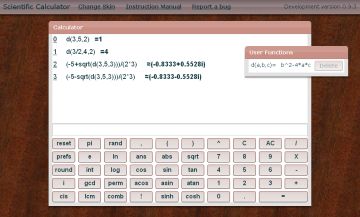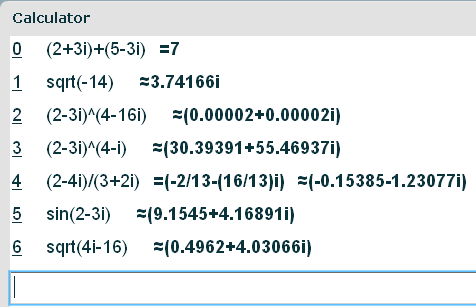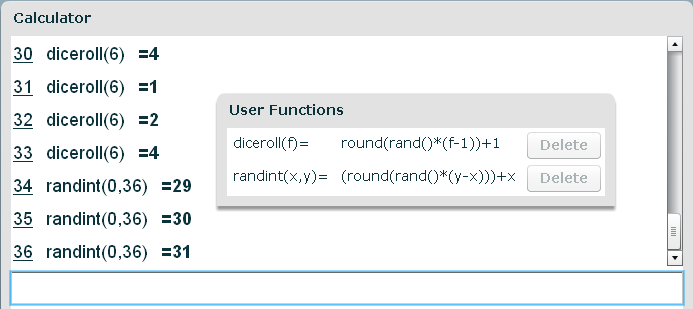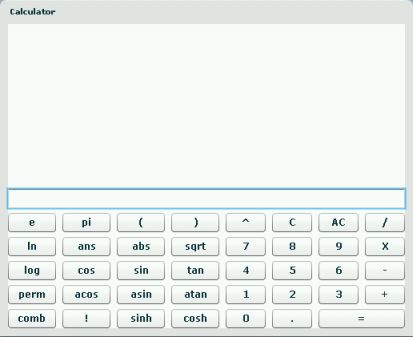Quadratic equations are very easy to solve using a calculator. Alcula’s scientific calculator makes it even easier. This is the first of a series of examples of how entering commonly used formulas as user defined functions into the scientific calculator can help you streamline your work, weather your are checking your homework or verifying the solutions to the exercises in your math textbook.
Archive for the ‘Online Scientific Calculator’ Category
How to solve Quadratic Equations
Tuesday, March 16th, 2010Scientific calculator skins
Monday, March 8th, 2010Following the nice comments received about the new calculator’s functionality, and since no new bugs were reported, I had time to work a bit on the scientific calculator’s look. The new version adds two user selectable color themes: ‘Wooden’ and ‘Smoke’, the original theme is now called ‘Classic’.

Wooden
Complex Numbers Calculator (The Square Root of -1 is not NaN)
Tuesday, January 19th, 2010The online scientific calculator now supports complex numbers operations. Complex numbers can be input in Cartesian, Polar, or Exponential form. You can also use the calculator to convert to and from cartesian, polar or exponential. Read on to find out more.
Scientific Calculator Notation and Precision
Monday, January 11th, 2010How to change the notation and precision displayed by the online scientific calculator
The latest release of the online scientific calculator includes a new functionality: The preferences window. Here you can set the display format for the calculator results. This article gives a bit more information on how the calculator stores numbers internally, it’s precision limitations and explains how to use this new feature.
How to use the Random Function of the Scientific Calculator
Thursday, December 17th, 2009As seen in a previous post, the new online scientific calculator now has a random generator function. This article describes the new function in detail and how to use it for generating random integers within a specified interval or for simulating random events such as the rolling of a dice.
Least Common Multiple (LCM) and ROUND functions added to the calculator
Wednesday, December 9th, 2009The LCM and ROUND functions have been added to Alcula’s Online Scientific Calculator’s release 0.7.
This article describes what they are and how to use them.
Edit and Drag Functions
Tuesday, October 20th, 2009A few more improvements to the Online Scientific Calculator…
After implementing functions, in last version, this new release, 0.5, brings a bit of polishing to existing functionalities.
Here is what you will find in the new version:
- You can edit an existing function by clicking on it’s body
- The User Function window is now hidden automatically if no function is defined.
- The User Function window resizes to show the full text of the function.
- You can now drag a function from the User Function List to the calculator.
- Bigger keyboard and display for easier reading.
Custom functions and random number generator
Tuesday, October 6th, 2009A new version (0.4) of the scientific calculator was released last week, with a few more buttons, useful features, and bug fixes.
New features available in version 0.4:
- You can now define your own functions to use multiple times in expressions.
- A pseudo-random number generator.
- A reset function to clear the calculator window.
- A comma key to type functions with multiple parameters.
Alcula’s new Scientific Calculator
Friday, September 25th, 2009Welcome to the first article of Alcula’s blog. Here you will find fresh information about the website, it’s new features and tools as well as general news on the world of calculators, math and other things related.
The most important piece of news for the site is the addition of the new Scientific Calculator. This is what this post is all about.
It has taken many months of development and it’s far from being complete but even at this stage it is the most complete tool for making calculations online. The current version is available here.
So what does it do?
(more…)




